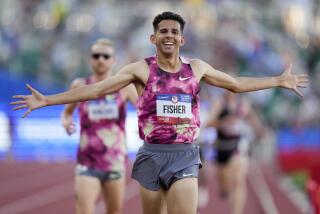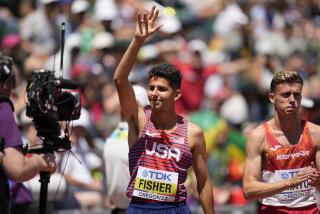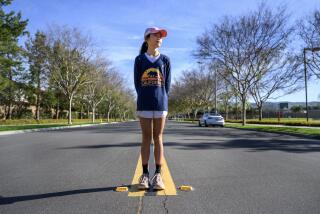New York City Marathon: Just Showing Up No Longer Enough
NEW YORK â This year, with the rival marathon in Chicago out of the running until spring, and with the appearance fees of top athletes spiraling out of control, the powers behind Sundayâs New York City Marathon were finally in a position to make an important political and financial decision.
Starting this year, with only a few exceptions, they will no longer pay top runners huge bonuses just to show up.
âCertainly, the amounts of money were just getting out of hand,â said race coordinator Allan Steinfeld. âRaces were being pitted against each other, people were bargaining with one race against another and the numbers were just skyrocketing.â
The result, with the best athletes going to the highest bidders, was that top runners would agree to start a race--for big chunks of money--but wouldnât necessarily run competitively, or even finish. The practice had gone on for years, first under the table and later openly, when appearance money became legal.
âThe times were so far off, and we felt it just wasnât fair to other athletes and to the sport,â Steinfeld said. âWeâd like to see athletes get paid for running well. So we will pay money at the finish line--not at the starting line.â
This yearâs prize money totals $274,000, with the menâs and womenâs winners each getting $25,000 and a Mercedes-Benz. There will be additional incentives for faster times under normal weather, as well as under hot and humid conditions, and bonuses of $10,000 and $5,000 to Americans who finish among the top three.
The only runners who will receive appearance money, Steinfeld said, will be former winners, which means defending champion Gianni Poli and two-time winner Orlando Pizzolato, both of Italy; four-time winner Bill Rodgers, and 1981 womenâs winner Allison Roe of New Zealand, plus past Olympic medalists, this year 1972 gold medalist Frank Shorter.
The only other exceptions would have been those with the fastest times in the world, Portugalâs Carlos Lopes, who holds the world record of 2 hours 7 minutes 12 seconds for the 26.2-mile distance, and Welshman Steve Jones, who has run the distance a second slower.
Sources said, however, that New York Road Runners Club officials abandoned negotiations with both Lopes and Jones because each was demanding about $100,000.
Ingrid Kristiansen of Norway, the womenâs world record-holder who ran 2:21:06 in the 1985 London race, has chosen not to run here, and 1984 Olympic gold medalist Joan Benoit Samuelson, who holds the second fastest time in the world, of 2:21:21, gave birth to her first child, Abigail, last weekend and presumably wonât be competing for several months.
The New York clubâs decision was attacked by some and applauded by others.
âI believe you should run and get paid for what you do, not just for showing up,â said Bob Sevene, coach of both Nike Boston, a club of young athletes, and the elite Athletics West.
Greg Meyer, the 1983 winner of the Boston Marathon, who will run here Sunday, disagreed. Coincidentally, he is coached by Sevene.
âWhen there are so few marathons of quality that have to compete against each other, you have to give money,â he said. âAppearance money is a reality in the sport. Thereâs no one going head to head with Fred (Lebow, president of the New York Road Runners Club) this year, and that allows him to do this.
âIf New York had anybody to compete against, theyâd have to pay appearance money if they wanted certain runners. Fredâs not concerned with the race; heâs always been concerned with putting on a show. Heâs not concerned with building a field; heâs concerned with bringing in the names.â
For the last several years, Lebow had been waging a fierce and sometimes nasty bidding war for the worldâs best marathoners with Bob Bright, director of Americaâs Marathon/Chicago. The Chicago race, beset by problems and shaky sponsorship, was not run this fall and has moved to the spring.
Rodgers agreed with Meyer.
âI think itâs a one-year decision,â Rodgers said. âI think after the 1988 Olympics, when Fred wants to get the top Olympic athletes, they will offer appearance money again. Why not? Why should the New York City Marathon be a second-level competition. A high-quality marathon should have the best in the world.â
Despite the debate, the field this year looks competitive, and it may be more so if the money is paid to top finishers, rather than top starters. The top entrants, besides those collecting appearance fees, include Moroccan Nechchadi el Mostafa, second-fastest in the world this year at 2:10:09; Englishman Hugh Jones, third-fastest at 2:10:11; Scotsmen John Graham, whose best is a 2:09:28 in 1981, and Alister Hutton, whose best is a 2:09:16; Tanzanians Agapius Masong, whose best is 2:10:42, and John Bura, who has run 2:11:27, and Kenyans Ibrahim Hussein and Geoffrey Koech.
Also running will be Rodolfo Gomez and Dan Schlesinger, who, with Alberto Salazar, contributed to the most exciting New York finish ever in 1982. Salazar beat Gomez by four seconds, and Schlesinger was a close third.
Americans in the field include Rodgers, Shorter, Meyer, Long Islander Pat Peterson, and 1984 Olympians Peter Pfitzinger and John Tuttle.
Although Rodgers and Shorter continue to be big draws in the running world, neither is expected to win. Shorter, however, who turns 40 today, certainly has a chance to win in his age group, or even set a new masters record.
Rodgers, who will turn 40 Dec. 23, has been plagued by financial troubles this year, caused by the failure of his clothing line, which he no longer owns. Shortly before last springâs Boston Marathon, however, he learned that he was still responsible for the original loan on the business, even though he had sold the company.
âIt affects my training, my focus,â he said. Even so, he said, he is âin shape to race anyone my age or older.â
Sevene, who has been studying the field, said Meyer could finish well--if he exercises some discipline.
âIf Greg runs smart, he could be the first American,â Sevene said. âThat means he has to use this race to learn to run from behind. That could be hard for him, since he likes to be up front. But on this course, runners have had great success running from behind. Pizzolato has made a science out of it.â
The womenâs field this year is notable for those not running. Norwegian Grete Waitz, who has dominated the New York City Marathon since 1978, winning every year except 1981, when she dropped out with injuries, will not line up Sunday. She is still recovering from a stress fracture that prevented her from defending her title in the marathon at the World Championships last summer in Rome.
âItâs pretty bad,â she said. âItâs probably the worst injury Iâve ever had. I was very disappointed that I couldnât run in Rome. I knew I was in very good shape.â
The top women include former winner Roe, who set a course record that was also a world record at the time, 2:25:29 in 1981, but has been hampered by injuries ever since, and Priscilla Welch of England, who, at 42, holds the world masters record of 2:26:51 and is considered the favorite.
The big surprise of the womenâs race could turn out to be Cathy Schiro, who in 1984 at 16 was the youngest competitor in the Olympic womenâs marathon trials. Schiro, who finished ninth in the trials in 2:34:24 and is the former junior world record-holder, dropped out of sight shortly thereafter, disillusioned with competition.
More to Read
Sign up for Essential California
The most important California stories and recommendations in your inbox every morning.
You may occasionally receive promotional content from the Los Angeles Times.










